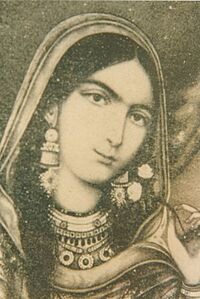Begum Hazrat Mahal facts for kids
Quick facts for kids Begum Hazrat Mahal |
|
|---|---|
| Begum of Nawab of Awadh | |

Begum Hazrat Mahal
|
|
| Born | Muhammadi Khanum 1820 Faizabad, Awadh |
| Died | 7 April 1879 (aged 59) Kathmandu, Kingdom of Nepal |
| Husband | Nawab Wajid Ali Shah |
| Religion | Shia Islam |
Begum Hazrat Mahal (born around 1820, died 7 April 1879) was a brave queen from Awadh, India. She was also known as the Begum of Awadh. She was the second wife of Nawab of Awadh Wajid Ali Shah. She became famous for leading a big fight against the British East India Company during the Indian Rebellion of 1857.
After her husband was sent away to Calcutta, the Indian Rebellion began. Begum Hazrat Mahal made her son, Prince Birjis Qadr, the new ruler of Awadh. She helped him rule because he was still young. However, she had to leave this role after a short time. She eventually found safety in Nepal, where she passed away in 1879. Her important role in the rebellion made her a hero in India's history.
Contents
Biography of Begum Hazrat Mahal
Early Life and Royal Connections
Begum Hazrat Mahal's first name was Mohammadi Khanum. She was born in 1820 in Faizabad, which used to be the capital of Awadh. She joined the royal household and was known as Mahek Pari.
She became a Begum after marrying the King of Awadh, Wajid Ali Shah. She became his junior wife. She received the title 'Hazrat Mahal' after her son, Birjis Qadr, was born. In 1856, the British took over Awadh. Wajid Ali Shah was sent away to Calcutta. Begum Hazrat Mahal stayed in Lucknow with her son. She soon took charge of Awadh as it fought against the British East India Company.
Leading the Indian Rebellion of 1857
During the Indian Rebellion of 1857, Begum Hazrat Mahal's supporters fought against the British. They were led by Raja Jailal Singh. They took control of Lucknow. Begum Hazrat Mahal became the leader for her young son, Prince Birjis Qadr. She declared him the ruler of Awadh. As a result, she took a main leadership role in the rebellion against the British.
One of Begum Hazrat Mahal's main complaints was that the East India Company had destroyed temples and mosques. They did this just to build roads. In a message during the revolt, she questioned the British claim to allow religious freedom. She pointed out that the British seemed to disrespect local religions. She said they ate forbidden foods and used animal fats that offended both Hindus and Muslims. She also mentioned that they built churches and taught Christianity. She asked how people could believe their religion would be safe.
Hazrat Mahal worked with Nana Saheb. Later, she joined the Maulavi of Faizabad in an attack on Shahjahanpur. When the British forces took back Lucknow and most of Awadh, she had to leave.
Life After the Rebellion
Finally, Begum Hazrat Mahal had to go to Nepal. At first, the prime minister, Jung Bahadur Rana, did not want to let her stay. But later, she was allowed to live there.
She passed away in Nepal in 1879. She was buried in a simple grave in the grounds of Kathmandu's Jama Masjid.
After her death, the British Government forgave her son, Birjis Qadr. He was allowed to return home in 1887 during Queen Victoria's jubilee.
Remembering Begum Hazrat Mahal
Begum Hazrat Mahal's tomb is in the center of Kathmandu. It is near Jama Masjid, not far from Darbar Marg. The Jama Masjid Central Committee looks after her tomb.
On 15 August 1962, Begum Hazrat Mahal was honored in Lucknow. This was for her important role in the Great Revolt. The Old Victoria Park in Hazratganj was renamed after her. A marble memorial was built there. It has a marble tablet with four brass plaques. These plaques show the royal family's symbols. The park is used for festivals like Ramlila and for the Lucknow Mahotsava (Lucknow Exposition).
On 10 May 1984, the Government of India released a special stamp to honor Mahal. The stamp was designed by C.R. Pakrashi. A total of 1,500,000 stamps were issued.
The Ministry of Minority Affairs, Government of India has started a scholarship in her name. It is called the Begum Hazrat Mahal National Scholarship. This scholarship helps talented girls from minority groups in India. The Maulana Azad Education Foundation manages this scholarship.
Images for kids
-
Memorial of Begum Hazrat Mahal in Begum Hazrat Mahal Park, Lucknow.




